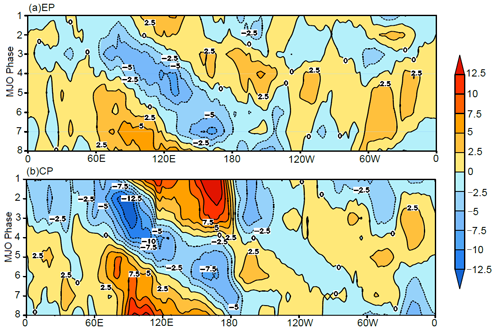Madden–Julian Oscillation Exhibits Distinct Features during Two Types of El Nino
Date:2016-05-31
Traditionally, El Ni?o is associated with warm ocean water that develops in the eastern Pacific (“EP El Ni?o”). Recently, a different type of El Ni?o, characterized by a warm sea surface temperature (SST) anomaly in the central Pacific, has been widely discussed (“CP El Ni?o”). The two types of El Ni?o exert different influences on both regional climate and global climate via teleconnection. Moreover, recent studies have shown that CP El Ni?o events have occurred more frequently since the beginning of the 1990s, as compared to EP El Ni?o events. Therefore, it is necessary to examine the different responses of the Madden–Julian Oscillation (MJO) to the two types of El Ni?o events.

Contrast of sea surface height anomalies of El Nino in 1997 and 2015 (image from http://climate.nasa.gov/)
The features of the MJO during the two types of El Ni?o events for the period 1979–2012 are investigated in a study recently published in Advances in Atmospheric Sciences. In this study, scientists from Institute of Atmospheric Physics (CAS), South China Sea Institute of Oceanology(CAS) and Sun Yat-Sen University reveal that the MJO exhibits distinct features during EP El Ni?o events, as compared to CP El Ni?o events.
The variance of 30–60-day outgoing longwave radiation (OLR) and 200-hPa velocity potential are applied to identify the MJO intensity. It is found that the strongest difference occurs between the tropical eastern Indian Ocean and western Pacific. Both variables lead to the conclusion that the intensity of the MJO is weak during EP El Ni?o, but stronger during CP El Ni?o.

Composite anomalies of 30–60-day OLR variance and SST. (Pang et al., 2016)
Additionally, the propagation features of MJO-related convection are contrasted between the two types of El Ni?o. For EP El Ni?o, MJO-related convection emerges over the eastern Indian Ocean and can propagate farther eastward into the central Pacific (to nearly 120°W). During CP El Ni?o winters, MJO-related convection emerges over the western Indian Ocean and can only propagate to the dateline, and there are no clear convection anomalies to the east of 180°. The implication of this finding is that the propagation extent of the MJO may be bounded to the abnormally warm area over the tropical Pacific.

Composite anomalies of 30–60-day OLR in the tropics (averaged over 10°S–10°N). (Pang et al., 2016)
It is also found that the frequency in the eight phases of the MJO differs between the two types of El Ni?o. In general, MJO-related convection appears more frequently over the western Pacific during boreal winter. However, the occurrence of MJO-related convection is relatively high (nearly 35%) over the Indian Ocean (phases 2 and 3), while it is low (only 18%) over the Maritime Continent (phases 4 and 5) during EP El Ni?o. During CP El Ni?o winters, the most frequent occurrence lies over the Maritime Continent (nearly 40%) and the least frequent occurrence lies over the Western Hemisphere (less than 15%).
Reference
Pang, B., Z. S. Chen, Z. P. Wen, and R. Y. Lu, 2016: Impacts of Two Types of El Ni?o on the MJO during Boreal Winter. Adv. Atmos. Sci., doi: 10.1007/s00376-016-5272-2 (in press).
Contact: PANG Bo, pangbo14@mails.ucas.ac.cn
